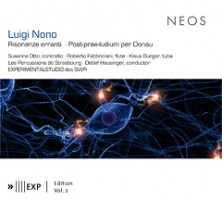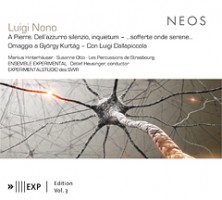Maestro di Suoni e Silenzi: Necessary Nono 3.
|
Grant Chu Covell [February 2013.] Luigi NONO: Risonanze erranti a Massimo Cacciari (1986/87)1; Post-prae-ludium per Donau (1987)2. Ensemble Experimental: Susanne Otto1 (c-alto), Roberto Fabbriciani1 (fl), Klaus Burger1, 2 (tuba); Les Percussions de Strasbourg1; Experimentalstudio des SWR: Reinhold Braig1, Joachim Haas1, 2, Gregorio Karman1, Michael Acker2, André Richard1, 2 (supervisor); Detlef Heusinger1 (cond.). NEOS 11119 (1 SACD) (http://www.neos-music.com/). I hadn’t expected to take such a recess in covering recent Nono releases (installments One and Two). A fresh NEOS sparks this roundup and forces an overdue confrontation with col legno’s Prometeo (here’s what Dan said). However, Risonanze erranti’s premiere recording tops the stack. Revisiting it now, I know why I took a break: “Wandering resonances” completely baffled this Nono admirer. The echo effects, wafting contralto and slo-mo tuba accented with flute and chimes sounded dated and silly. I imaged cavorting whales, mid-70s avant-garde and Laugh-In punch lines. Perhaps the work’s 40 minutes avoids capture in a recording. Perhaps the spatial effects have to be experienced live. The light warbling breaths and high-brass effects are interesting and the mutated voice provides color, yet overall, the music plays as self-indulgently incomprehensible. Flute and tuba fail to achieve the same effective alternation of bursts and silence so effectively employed in No hay caminos, hay que caminar… Andrei Tarkovsky. The texts employ disassociated words from Herman Melville’s Battle Pieces, Ingeborg Bachmann’s Keine Delikatessen, and syllables (“echi”) derived from Desprez, Machaut and Ockeghem. The seriously intoned “hunger… despairing… death…” quickly becomes puerile. Perhaps the booklet fails to explain, or perhaps I’m not a true fan. The tuba-plus-electronics work, Post-prae-ludium per Donau, is remarkable for the manner in which it obscures repetitions. The tuba’s low pedal tones looped with reverb impress. Interest is maintained not simply because it’s shorter – 13:39 compared to Risonanze’s 40:18 – but rather that its limited materials yield greater rewards. And there are no elliptical texts. Luigi NONO: Prometeo, Tragedia dell’ascolto (1981/1985). Petra Hoffmann, Monika Bair-Ivenz (sop), Susanne Otto, Noa Frenkel (alt), Hubert Mayer (ten), Sigrun Schell, Gregor Dalal (speakers); Solistenchor Freiburg; ensemble recherche; Solistenensemble des Philharmonischen Orchesters Freiburg; Solistenensemble des SWR Sinfonieorchesters Baden-Baden und Freiburg, Experimentalstudio der Heinrich-Strobel-Stiftung des SWR, Freiburg, André Richard (dir.), Peter Hirsch, Kwamé Ryan (conds.). col legno WWE 2 SACD 20506 (2 SACDs) (http://www.col-legno.com/). Col legno’s Prometeo packaging encloses two discs (69:38 + 64:54) and two booklets. The 115-page red booklet offers the Listening Score. A magnifying glass will help you better appreciate the multi-colored layout. The dark-purple 83-page booklet provides notes and bios. This Prometeo is an astounding aural treat even in two-channel sound. The wafting echo effects, the soloists tinged with electronics and the swirling massed chorus provide a good deal of interest and fun, though it’s difficult to figure what’s going on: Nothing moves predictably. We’re on a raft in stormy seas. We associate Prometheus with fire, yet Prometeo suggests undulating water. However, if power indeed suggests fire, strengths are clearly at work. Prologo and Isola 1 seethe with repressed force, alternating silence and action. Old hand André Richard nicely handles Nono’s subtle electronic manipulation. Despite the chorus’ peppy inflections in Isola 2a Io-Prometeo, the effects aren’t dated. I confess, or repeat what I’ve said, that most texts in music rarely penetrate my comprehension. Many composers and listeners value Hölderlin immensely, yet he fails to open vistas or even entertain me. Nono does get up to some appealing effects in Isola 2b Hölderlin with echoes, a slowly moving clarinet and electronic effects. Much of Prometeo’s meaning will always elude me, but I can certainly enjoy the sounds gliding by. Perhaps it’s foolish to attempt Prometeo without an understanding of the Greek, Italian and German bits. Nono doesn’t offer easy markers. In replaying Prologo, Isola 1 and Isola 2, I remain pleasurably lost. Moving into the second disc, the pulse slows and content becomes less erratic. Electronic effects include a whispered acidic rattle resembling labored breathing through an intercom. Tre voci a delivers forceful rolling blankets of soaring voices over slowly spreading electronic pedals similar to the looped onslaughts in Quando stanno morendo. Again, repeated listening doesn’t increase familiarity. Prometeo grows elusive and mysterious even toward the end where textures thin and become more ‘isola’-ted. Prometeo doesn’t wither: It recedes, gathering strength in the distance. Comparing with Metzmacher’s o/p EMI / Ricordi 7243 5 55209 2 0, Hirsh/Ryan/Richard carve out foregrounds and backgrounds. Colleague Dan has already pointed out similarities in durations and how Prometeo can play tricks with perceived time. The older release captures audience noises including coughing. While EMI’s spoken voices in the Prologo are slightly more distinct, I find that they distract. With its broader sound spectrum, Hirsh/Ryan/Richard is the winner. If Metzmacher’s peaks surprise more, this is likely so because we don’t hear as much resolution below the music’s median threshold. Luigi NONO: A Pierre. Dell’azzurro silenzio, inquietum (1985)1; …sofferte onde serene… (1976)2; Omaggio a György Kurtág (1983/86)3; Con Luigi Dallapiccola (1979)4. Markus Hinterhäuser2 (pno), Ensemble Experimental: Susanne Otto3 (c-alto), Roberto Fabbriciani1, 3 (fl), Ernesto Molinari1, 3 (clar), Klaus Burger3 (tuba), Detlef Heusinger3 (cond.); Les Percussions de Strasbourg4; Experimentalstudio des SWR: Michael Acker,Reinhold Braig, Joachim Haas, Thomas Hummel, André Richard(supervisor). NEOS 11122 (1 SACD) (http://www.neos-music.com/). It would be terrible if my incomprehension of Risonanze erranti could be attributed to its unfamiliarity or that I think of Nono as someone he isn’t. Vol. 3 in NEOS’ series offers old friends fewer surprises. Applying simplistic labels gives us Early-Political-Nono and Late-Questioning-Nono. My favorite piece in Vol. 3 falls into the gap. The work for Pollini, …sofferte onde serene…, never ceases to amaze. There are no paeans to murdered revolutionaries, no whispering electronics. The instrument shudders as if a piano tuner were determined to remove something that had become entangled in the strings. The blunt piano and its loud, richly textured accompanying taped piano contradict Nono’s later aesthetic. Indeed, the tape transmits otherwise impossible attack and pedal combinations. Later works control their anger; here it’s unconstrained. Hinterhäuser took a crack at this before. I think sometime in the early part of this century Ricordi cleaned up the tape. Given the profusion of pitched and non-pitched percussion, Con Luigi Dallapiccola for six percussionists and electronics reflects Nono’s early serial thinking. It’s not easy to pick out the ring modulation and frequency generators except when a resonant haze covers the ensemble. Clearly an homage, the title’s “with” marks Nono’s solidarity with Dallapiccola in a brotherhood of political and serial Italian komponists. Nono also borrows pitch material from his elder compatriot. Omaggio a György Kurtág responds to that composer’s Omaggio a Luigi Nono. Where Kurtág uses chorus, Nono uses alto voice, flute, clarinet, tuba and electronics. The work, which started as an improvisation for Nono’s core group of musicians, was notated in 1986. I wonder how close Boulez and Nono were. Written for the former’s 60th, A Pierre. Dell’azzurro silenzio, inquietum strikes as a strange sort of homage given the composers’ aesthetic disparities by the mid-80s. Disembodied bass flute and contrabass clarinet growl and circle resplendently. I’m not going to trade in my older recordings featuring Nono and his original team. Given several of the principals’ participation (Fabbriciani, Otto, Richard), these have to be understood as authentic. In the booklet Jürg Stenzl quotes Nono’s most famous student, Lachenmann. The setup also bears repeating:
Lachenmann suggests that Nono was about contradictions that don’t really explain why, to these ears, some works are clunkers and others phenomenal. But who enjoys everything an artist creates? Certainly not I. “Prometheus: Musical Variations on a Myth. A Film by Christopher Swann.” Ludwig van BEETHOVEN: Excerpts from The Creatures of Prometheus, Op. 43 (1801). Franz LISZT: Symphonic Poem No. 5, “Prometheus” (1850). Alexander SCRIABIN: Prométhée: La Poème du Feu, Op. 60 (1910)*. Luigi NONO: Isola seconda: b) Hölderlin from Prometeo, Suite 1992 (1981-85)**. Martha Argerich* (pno), Ingrid Ade-Jesemann**, Monika Bair-Ivenz** (sops), Ulrike Krumbiegel**, Matthias Schadock** (speakers), Michael Hasel** (b-fl), Manfred Preis** (cb-clar), Experimentalstudio der Heinrich-Strobel-Stiftung des Südwestfunks, Freiburg**: André Richard (dir.), Don-Oung Lee, Rudolf Strauß, Bernd Noll, Rolf Pfäffle, Berliner Singakademie*, Solistenchor Freiburg**, Berliner Philharmoniker, Claudio Abbado (cond.). Arthaus Musik 101 717 (1 DVD) (http://arthaus-musik.com/). Mentioning Prometeo provides an excuse to cover a music video / concert film featuring Nono’s music. Some may recall the 1994 Sony SK 53978 with this program; here’s a movie doubling most of it. Swann’s 1993 56-minute film mixes standard concert footage, slideshow and visual effects most creatively. The CD offers two movements from a Prometeo Suite 1992: Tre voci a and Isola 2b Hölderlin. Only the latter appears here. Given Nono having passed in 1990, presumably Suite 1992 is Abbado’s assemblage. The CD programs seven Beethoven excerpts; the movie employs the first four only. Swann’s four parts align with each composition: The Creator of Man (Beethoven), Bound and Liberated (Liszt), The Bringer of Light (Scriabin), and The Eternal Wanderer (Nono). Beethoven’s section includes nature scenes, artifacts from Classical civilizations and Blake drawings. Supertitles convey the Liszt program. Conventional orchestra shots alternate with a soaring eagle en route to Prometheus’ liver. The live Scriabin performance included a light show which bathes players and hall (I didn’t check the score to see how accurate). Superimposed flames accompany the chorus’s entry. The Nono part makes extensive use of posterized effects and water images. Avant-garde treatments include Abbado’s disembodied hands floating over blue and the bass flute seen in mirrors. Blurred lights designate a coda. I would have preferred to see Nono’s section unadulterated. Watching undistorted musicians would provide clues as to where the electronics step in. Nono: Prometeo, Tragedia dell’ascolto (1981/1985)
* not on DVD Nono: …sofferte onde serene… (1976)
Nono: Con Luigi Dallapiccola (1979)
Nono: Omaggio a György Kurtág (1983, 86)
Nono: A Pierre. Dell’azzurro silenzio, inquietum (1985)
Nono: Post-prae-ludium per Donau (1987)
[Previous Article:
Armchair Operas 8.]
[Next Article:
EA Bucket 16.]
|



